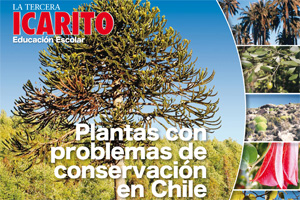Summaries
Chilean flora and factors that influence conservation problems.
– Chile has only 5,105 species, but it has a high degree of endemism (2,630 varieties).
– The main cause of the decrease in plant species is habitat fragmentation and reduction as a product of human activities: the use of forest land for agriculture and cattle farming, overpasturing, the forestry industry, the growth and development of urban areas and forest fires.
– Other factors that cause conservation problems in flora are: natural disasters, water and ground contamination and climate change.
Threatened species
– There are currently eleven Endangered species in continental Chile. Some species of this category are: Avellanita Bustillosii (Avellanita bustillosii), Southern Belloto (Beilschmiedia berteroana), Berberidopsis Corallina, and others.
– There are 63 endangered species in insular Chile. Some of the most threatened plants are: Apium fernandezianum, Asplenium stellatum, Chenopodium sanctaeclarae, Erigeron ingae, etc.
– From the point of view of conservation, there are 31 Vulnerable species of continental flora. Among these are: Araucaria (Araucaria araucana), Chilean Incense-Cedar (Austrocedrus chilensis) and Vasconcellea Chilensis (Carica chilensis).
– Some of the most representative species of the 40 in a Vulnerable state in Chile’s insular zones are: Acaena masafuera, Aplenium polyodon, Berberis corymbosa, Haloragis masafuerana, etc.
Measures to conserve species
– Some measures Chile is taking in regards to the protection of flora (mainly endemic) are: the conservation and sustainable management of wild flora by the Servicio Agrícola y Ganadero (SAG) (Agriculture and Livestock Service), the Chilean National System of Protected Areas (Spanish acronym SNASPE), plant propagation, international treaties and CONAF programs about the protection and recuperation of native Chilean flora.
– Some propagation methods for endangered plant species are: greenhouses, shadehouses, intermittent misting, heated propagation beds and germination chambers.
– CONAF’s objectives for its plans regarding the protection and recuperation of native Chilean fauna are: to determine the current situation of the populations with conservation problems, to incorporate threatened plant communities into the Chilean National System of Protected Areas (Spanish acronym SNASPE), and others.





